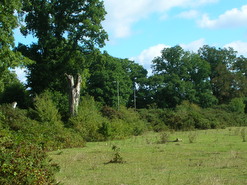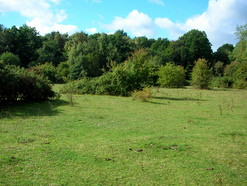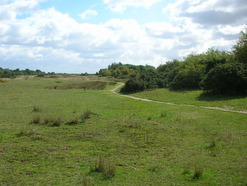Compartment 15 runs along the northwestern edge of the common, adjacant to Bury's Bank Road, and covers an area of 7.6 ha. It is not divided into subcompartments. The compartment contains a mix of grassland with fragments of remnant heath, pioneer communities on bare gravel substrate and scrub and mature trees. The area is adjacent to the Pyle Hill car park so is very well used by the public.
General description and evaluation of ecology
This compartment comprises a variety of habitats ranging from pioneer communities on gravelly substrates though to species-poor neutral grassland within which there are damper areas typified by rushes and willow scrub. There are some extensive stands of gorse and patches of mixed scrub with some individual small trees (hawthorn) and groups of mature trees. Mature trees include oak, notably some planted Turkey oak, birch and poplar. There are 3 juniper bushes that may have been planted. A number of exotic plant species have been introduced or have colonised from neighbouring gardens (e.g. pyracantha, cotoneaster). There are some interesting small inclusions of heather, lichen heath and acid grassland within this mosaic. Although generally level there are a number of small depressions and rises, within one of the former is a small ephemeral pool. Species known to use this part of the common include: linnet, common whitethroat, yellow wagtail, long-winged conehead, field grasshopper, meadow grasshopper and common green grasshopper. As with the rest of the common this compartment is of interest for the range of bryophytes that occur here - typically Brachythecium glareosum, Pseudoscleropodium purum, Dicranum scoparium and Ceratodon purpureus. Shorter grass swards can include Bryum capillare and Syntrichia ruralis along with Hypnum jutlandicum.
BAP habitats
None.
Higher Level Stewardship
Overall management objectives
Where fragments of lowland heathland, including lichen heath communities, and dry acid grassland exist these should be maintained and expanded if practicable, managing adjacent scrub to prevent encroachment. The bulk of the area is dominated by grassland with elements of scrub, this should be retained. Gorse should be managed to increase structural diversity and to prevent it flourishing at the expense of other adjoining habitats, namely grassland and heath. Areas of scrub should be maintained at their current extent. Although there are some introduced plant species it is thought that most of these do not detrimentally affect either the habitat or aesthetic appeal of this part of the common. They appear to be neither vigorous nor invasive in this environment. However, there are a number of Turkey oaks here which may cause problems in the future.
Compartment 15 (7.6 ha)



| Objective | Area | Method | Comment |
|---|---|---|---|
15.1) Control scrub.
HLS objective |
Throughout compartment. | Cut and collection of scrub. Cut and stump treat selected gorse and scrub to favour existing grassland.
Scrape selected small (10 m x 10 m) areas back to bare gravels using a mini digger to re-start succession on areas where gorse litter is significant. Keep stock fence clear of scrub on both sides. Maintain existing east-west path through compartment. Control Ragwort as necessary. Monitor for presence of Turkey oak seedlings, predominantly in northwest corner of compartment. Cut and treat Turkey oak saplings where they appear and treat seedlings with herbicide as necessary. |
See Gorse Management Plan (WBC 2012).
Mature gorse stands at western end have been important for Dartford warbler. Ragwort is an important native plant, particularly as a nectar source for invertebrates (cinnabar moth is now a BAP species). |
| 15.2) Maintain screen of gorse, trees and scrub alongside the main east-west path. | Coppice a small section each year and allow to re-grow to maintain a thick screen. | ||
| 15.3) Retain stands of mature trees. | Northwestern end of compartment. | Remove any dangerous limbs overhanging path, car park or roadside.
Reduce height and leave any dead trees as 'pegs'. Leave limbs where they fall (away from paths/car park/roadside). Pollard where necessary to prolong life and for wildlife benefits. |
Wildlife benefits for deadwood invertebrates (saproxylic beetles) and a host of mammals, birds, fungi, lichens and bryophytes. |